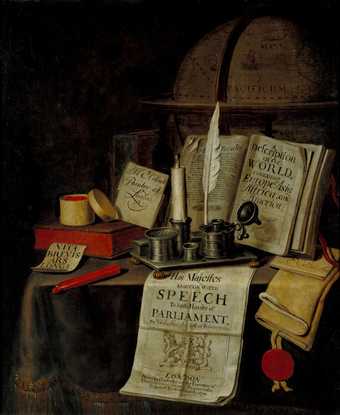
Fig.1
Edward Collier active 1662-1707
Still Life 1699
Oil paint on canvas
742 x 629 mm
N05856
This painting is in oil paint on canvas measuring 742 x 629 mm (fig.1). The single piece of linen canvas is plain woven with a thread count of 14 vertical and 16 horizontal picks per square centimeter. Cusping is present at the top, left and right edges but is not evident along the bottom (fig.2).1 There is a glue-paste lining and an adjustable pine stretcher, both of which appear to date from the late nineteenth or early twentieth century. As attested by the X-radiograph and the infrared reflectograph (fig.3), the painting has suffered from neglect in the distant past, with ragged edges and many small tears.
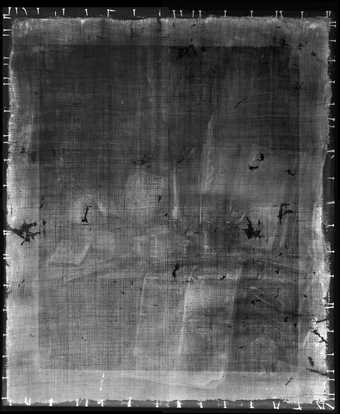
Fig.2
X-radiograph of Still Life 1699
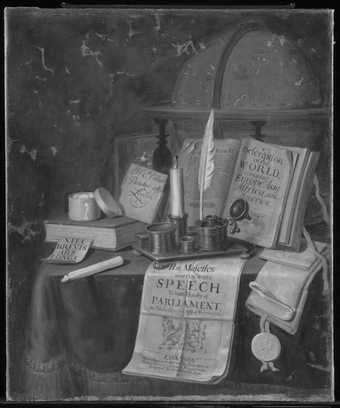
Fig.3
Infrared reflectograph of Still Life 1699
The ground is warm grey in colour. It is covered over with cool grey priming (figs.4–5). Lead white, chalk, red lead, black and red earth colour were found in the ground and priming (sampled together). It is possible that originally the red lead was not actually mixed into the paint for either layer but is present now as a result of the lead soap aggregates that permeate both layers.2 The ground and priming stop short of the top edge by about 12 mm and by 16 mm at the upright edges. They reach the bottom edge of the canvas, however, and this, in conjunction with the absence of cusping there, suggests that a small border of the painting has been removed.
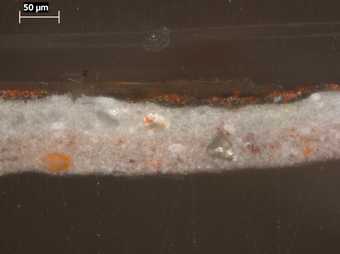
Fig.4
Cross-section through the top of the red book, photographed at x320 magnification. From the bottom: warm grey ground (with a lead soap aggregate present, showing bright orange); cool grey priming; thin dark background paint; red paint of the book; accumulated varnish
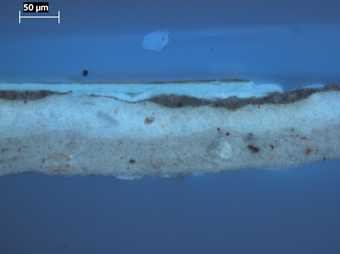
Fig.5
Cross-section through the top of the red book, photographed at x320 magnification in ultraviolet light. From the bottom: warm grey ground (with a lead soap aggregate present, which has turned into bright orange, red lead pigment); cool grey priming; thin dark background paint; red paint of the book; accumulated varnish
No underdrawing was detected using infrared reflectography or microscopy. The paint was applied smoothly with little sense of brushwork and almost no impasto. No pentimenti were detected and the composition appears very well planned and precisely executed. With close inspection, reserves can be seen for all the compositional elements, except the edges of the book and the red ribbons. The documents, painted first, exploit the cool grey priming with only thin scumbles of paint to model the fall of light.
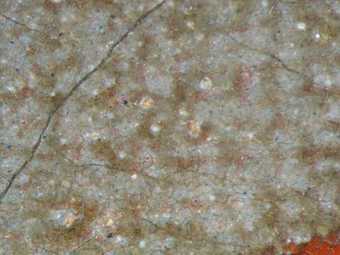
Fig.6
Detail of the tablecloth, photographed at x25 magnification, showing blue and red pigments in the grey matrix
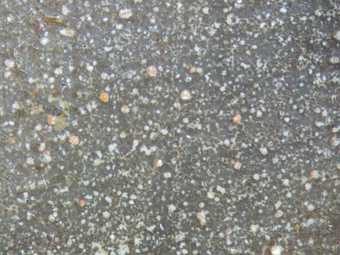
Fig.7
Detail of a shadowed fold in the tablecloth, photographed at x8 magnification, showing disruption of the surface by lead soap aggregates
The artist chose a muted palette with black, white and earth colours predominating.3 Smalt, indigo and red pigments are present in the tablecloth (fig.6) and the bright opaque red, vermilion, was kept for the red objects, glazed here and there with red lake. The only yellow pigment appears to be yellow ochre. The table cloth now appears grey but originally probably had a purple hue, due to the presence of blue and red pigments. There appear to be blue and red tones to the folds and shadows in the cloth but it is difficult to judge the colour due to the discoloured varnish, old retouchings and disruption due to lead soap formation. The whole of the painting’s surface is permeated by lead soap aggregates (fig.7). This is more apparent in areas with thin paint but protrusions are also visible in areas rich in lead white. Microcissing also is present in the latter (fig.8).4

Fig.8
Detail of the white letter leaning against the red book, photographed at x8 magnification, showing microcissing in the white paint
June 2005
